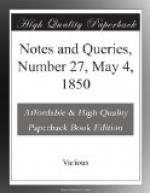Charms.—I beg to represent to the correspondents of the “NOTES AND QUERIES,” especially to the clergy and medical men resident in the country, that notices of the superstitious practices still prevalent, or recently prevalent, in different parts of the kingdom, for the cure of diseases, are highly instructive and even valuable, on many accounts. Independently of their archaeological {430} interest as illustrations of the mode of thinking and acting of past times, they become really valuable to the philosophical physician, as throwing light on the natural history of diseases. The prescribers and practisers of such “charms,” as well as the lookers-on, have all unquestionable evidence of the efficacy of the prescriptions, in a great many cases: that is to say, the diseases for which the charms are prescribed are cured; and, according to the mode of reasoning prevalent with prescribers, orthodox and heterodox, they must be cured by them,—post hoc ergo propter hoc. Unhappily for the scientific study of diseases, the universal interference of ART in an active form renders it difficult to meet with pure specimens of corporeal maladies; and, consequently, it is often difficult to say whether it is nature or art that must be credited for the event. This is a positive misfortune, in a scientific point of view. Now, as there can be no question as to the non-efficiency of charms in a material or physical point of view (their action through the imagination is a distinct and important subject of inquiry), it follows that every disease getting well in the practice of the charmer, is curable and cured by Nature. A faithful list of such cases could not fail to be most useful to the scientific inquirer, and to the progress of truth; and it is therefore that I am desirous of calling the attention of your correspondents to the subject. As a general rule, it will be found that the diseases in which charms have obtained most fame as curative are those of long duration, not dangerous, yet not at all, or very slightly, benefited by ordinary medicines. In such cases, of course, there is not room for the display of an imaginary agency:—“For,” as Crabbe says,—and I hope your medical readers will pardon the irreverence—
“For NATURE then has time to work
her way;
And doing nothing often has prevailed,
When ten physicians have prescribed, and
failed.”
The notice in your last Number respecting the cure of hooping-cough, is a capital example of what has just been stated; and I doubt not but many of your correspondents could supply numerous prescriptions equally scientific and equally effective. On a future occasion, I will myself furnish you with some; but as I have already trespassed so far on your space, I will conclude by naming a few diseases in which the charmers may be expected to charm most wisely and well. They will all be found to come within the category of the diseases characterised above:—Epilepsy, St. Vitus’s Dance (Chorea), Hysteria, Toothache, Warts, Ague, Mild Skin-diseases, Tic Douloureux, Jaundice, Asthma, Bleeding from the Nose, St. Anthony’s Fire or The Rose (Erysipelas), King’s Evil (Scrofula), Mumps, Rheutmatic Pains, &c., &c.




